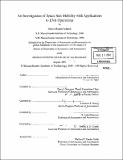An investigation of space suit mobility with applications to EVA operations
Author(s)
Schmidt, Patricia Barrett, 1974-
DownloadFull printable version (22.64Mb)
Other Contributors
Massachusetts Institute of Technology. Dept. of Aeronautics and Astronautics.
Advisor
Dava J. Newman.
Terms of use
Metadata
Show full item recordAbstract
The primary aim of this thesis is to advance the current understanding of astronauts' capabilities and limitations in space-suited extravehicular activity (EVA) by compiling a detailed database of the torques needed to bend the joints of a space suit, developing models of the mechanics of space suit joints based on experimental data, and utilizing these models to estimate a human factors performance metric, the work envelope for space suited EVA work. A detailed space suit joint torque-angle database is compiled in a novel experimental approach that uses space-suited human test subjects to generate realistic, multi-joint motions, which are used to drive an instrumented robot to measure the torques required to accomplish the motions in a pressurized space suit. Based on the experimental data, a mathematical model using the Preisach hysteresis modeling technique is developed to predict joint torque from the joint angle history. Two physics-based models describing the bending load-deflection characteristics of pressurized fabric cylinders were compared to the experimental space suit data. The beam model assumes that bending deflections are completely attributable to elongation of the fabric cylinder wall, while the membrane model assumes that the fabric never stretches. (cont.) The experimental data corresponds closely with the membrane model, implying that space suit joint stiffness is primarily determined by volume changes as the joint bends and the resulting compression of the gas inside the space suit. The space suit models were applied in a computational work envelope analysis to determine the volume in which a space-suited astronaut can comfortably work. A new method that uses inverse kinematics and the space suit model to calculate a work envelope based on visibility constraints and human strength limits is developed. Sensitivity analysis of the work envelope indicates that improving shoulder mobility and upward and downward visibility enlarge the space-suited work envelope.
Description
Thesis (Ph. D.)--Massachusetts Institute of Technology, Dept. of Aeronautics and Astronautics, 2001. Includes bibliographical references (p. 193-196).
Date issued
2001Department
Massachusetts Institute of Technology. Department of Aeronautics and AstronauticsPublisher
Massachusetts Institute of Technology
Keywords
Aeronautics and Astronautics.